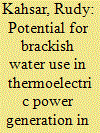| Srl | Item |
| 1 |
ID:
178262


|
|
|
|
|
| Summary/Abstract |
Drought is a major challenge threatening agricultural productivity in uMsinga. The occurrence of drought is expected to increase in coming decades, intensifying in severity, duration and the way people are affected by drought. The objective of this study is to understand small-scale farmers’ and rural communities’ perceptions of drought, its environmental and socio-economic impacts, adaptive and mitigation measures at household level and their satisfaction with the government’s role in drought management in the community. The study utilized a combination of quantitative and qualitative research methods, in the form of questionnaires, focus groups and key informant interviews. The sample size for the research study was 180 respondents for the questionnaire component and a total of 30 respondents for the focus groups and key informant interviews. The results show that increased levels of poverty, food insecurity and increased migration were the main socio-economic impacts perceived by respondents. Water scarcity, crop failure, forest degradation and an increase in average temperatures were perceived by respondents as the main environmental impacts caused by drought in uMsinga. Respondents perceived drought as a serious threat to agricultural production and adopted various indigenous adaptive strategies. A majority of respondents adopted a reactive approach to drought management, and therefore did not adopt many mitigation measures.
|
|
|
|
|
|
|
|
|
|
|
|
|
|
|
|
| 2 |
ID:
171415


|
|
|
|
|
| Summary/Abstract |
Threatened by a changing climate and the increased frequency of droughts and heat waves, more attention is being given to the sourcing of water resources. Especially in the American southwest, the frequency and severity of water shortages as well as elevated surface water temperatures has resulted in a series of threatened or imposed curtailments of thermoelectric power, the largest withdrawer of water in the United States. These cuts in generation can have important implications for the reliability and dispatchability of electric power, especially in summer months when electricity is needed most. This paper examines the potential for using brackish groundwater as a supplemental water source for thermoelectric power generation in seventeen western states and finds that the conversion of drought prone facilities to brackish backup systems would cost on the order of 60–70 thousand dollars per installed megawatt. Action from the federal government to foster basic research and technology readiness combined with state level action to require water resource contingency planning would encourage deployment of brackish water backup systems that would subsequently ensure resiliency and reliability of thermal generation during heat waves and in times of drought.
|
|
|
|
|
|
|
|
|
|
|
|
|
|
|
|